Fred Sexton’s Modernist Painting “Death of Monalita” Becomes Fourth Post Black Dahlia Artwork Believed Linked to 1947 Murder- A Sexton Confession On Canvas?
September 21, 2019
Los Angeles, California
Before examining this new linkage, I would recommend that readers review Fred Sexton’s biography as summarized in my original blog of July 2007.
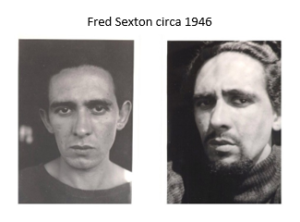
Fred Sexton Bio 1907-1995
HERE
As outlined in Fred Sexton’s biography we discover that prior to his painting the “Death of Monalita” in 1955, Fred Sexton was involved in the sexual abuse and molestation of his own pre-teen daughter (ages 8-11) from 1940-1944.
In 1949-50, Sexton would subsequently admit, in court testimony, to being an accomplice with his good friend, Dr. George Hodel and two adult females to the sexual molestation of my then fourteen-year-old half-sister, Tamar Hodel.
In 1950, Sexton also admitted to his wife, Gwain Sexton to having had sexual relations with his daughter when she was a child.
Sexton divorces Gwain, remarries and commits additional and separate child molestation acts with his new stepdaughter in the late Sixties and after removing reportedly 1.5 million dollars from his wife’s bank account, subsequently flees to Mexico to avoid arrest where he remarries a teenager at age sixty and dies in Guadalajara in his eighties.
This quote from Mark Nelson/Sarah Bayliss “Exquisite Corpse”:
A Critical Examination of Fred Sexton’s artwork, “Death of Monalita” (1955)
Who was “Monalita”?
I do not know. The name literally translates as “Little Mona.”
To date, I have no background information on Sexton’s painting other than it was reportedly created circa 1955. And at one time believed offered for sale at the Calabi Art Gallery.”
Sexton created the painting approximately eight-years after the murder of Elizabeth “Black Dahlia” Short in 1947, and some five-years after his good friend, Dr. George Hill Hodel fled Los Angeles to avoid arrest for the crime.
Since “art” is in the eye of the beseer, I will describe what I AM SEEING.
-
The center painting appears to be a skeletal structure showing what appears to be human vertebrae and ribcage.
-
Next, my eye is drawn to a figure and upper torso bisected at the waist, with arm extended in the “Minotaur” position.
-
Thirdly, there is a woman’s breast, which appears excised from the body.
-
Finally, I see a pair of woman’s lips and lower jawline.
Are these depictions merely random or is the artist presenting “clews” to an infamous crime that he would have been directly aware of if not actually involved in as an accomplice to the murder?
3) Excised woman’s breast
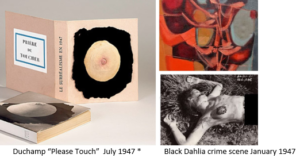
-
Duchamp’s “Please Touch” was published just six months after the murder and posing of Elizabeth Short’s body on the vacant lot in Los Angeles, California. See my 2016 blog “Were Marcel Duchamp and Man Ray’s 1947 “Priere de toucher” (Please Touch) Artworks Inspired by Dr. George Hodel’s Surrealist Crime Scene Masterpiece?
4) Posed Minotaur position
A Second Opinion: Graphics and Text Summary by Author and
Retired Dallas PD Officer Robert J. Sadler
Click on individual photos to enlarge.
Review of the four surrealists paintings now linked as “Thoughtprints” establishing the separate artists’ knowledge of Dr. George Hill Hodel’s “Murder As A Fine Art Sculpture.” (Shown in chronological order as they were presented to the public.) For a complete explanation of linkage, see author’s books and a keyword search on each identified painting in the author’s blog page.
-
Fred Sexton’s “Death of Monalita” (1955)
William Copley’s, “It is Midnight Dr. ____.” (1961)
-
Marcel Duchamp’s, Etant Donnes (1969)
SKH Note– The additional surrealist artworks used as “inspiration” by Dr. George Hill Hodel are not shown in this summary, which is limited to the surrealist’s works created after the murder and acknowledging their knowledge and linkage to the Black Dahlia Murder and her killer.
Those separate artworks inspiring and related to the Black Dahlia crime include:
Man Ray’s- The Minotaure
Man Ray’s- L’Equivoque
Man Ray’s- The Lover’s Lips
Man Ray’s- Juliet Stocking Mask
Man Ray/Copley- Alphabet for Adults
Man Ray’s- The Occuliste
Duchamp’s- “Priere de toucher (Please Touch)
_________________________________________
HODEL, HUSTON, SEXTON, THE THREE AMIGOS
As previously documented, George Hodel, Fred Sexton, and John Huston were close friends from their high school years forward through the decades. Huston had Sexton sculpt his “Black Bird” for The Maltese Falcon in 1941. (Currently appraised at $4 million.) Below is a link to an excellent article published in Vanity Fair in 2016, documenting the history and mystery of Sexton’s sculpture.
BELOW PHOTO OF FRED SEXTON’S SCULPTURE OF “THE BLACK BIRD” USED IN JOHN HUSTON DIRECTED 1941 FILM, “THE MALTESE FALCON”

VANITY FAIR- HWD
The Mystery of the Maltese Falcon,
One of the Most Valuable Movie Props in History
A statuette from the John Huston-Humphrey Bogart classic, The Maltese Falcon is one of the most recognizable, and sought-after, pieces of movie memorabilia in history. In fact, Steve Wynn paid $4.1 million for it. But was it the genuine article? Bryan Burrough tracks down a flock of Falcons, with links to both Leonardo DiCaprio and a famous Hollywood unsolved murder.
By BRYAN BURROUGH
https://www.vanityfair.com/hollywood/2016/02/mystery-of-the-maltese-falcon#5
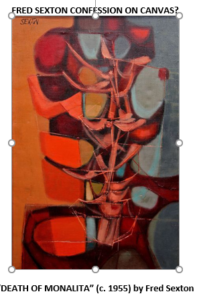
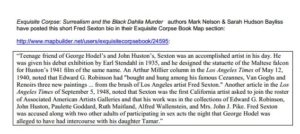
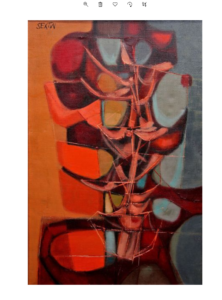
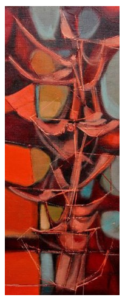
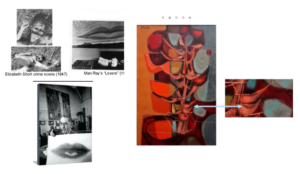
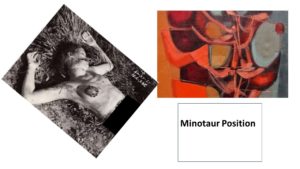
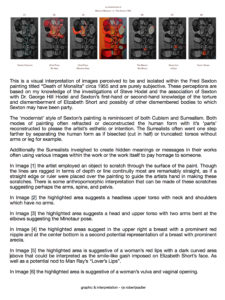
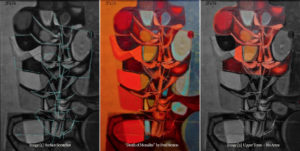
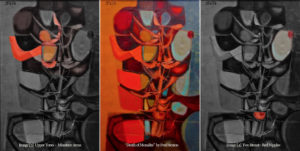
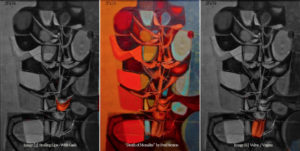
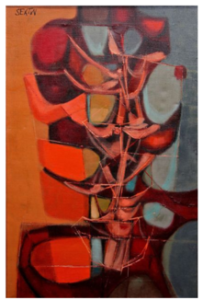
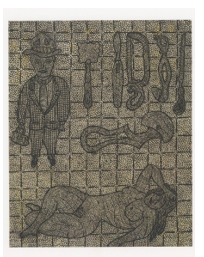
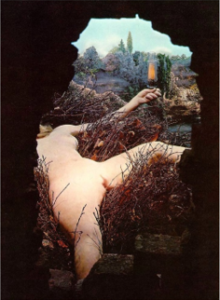
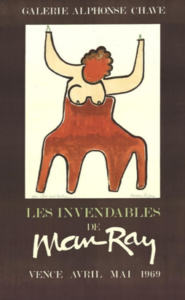

Hi Steve:
I’ve read all of your books. Just a truly fascinating real life story. As I looked at the Sexton painting, I noticed a horizontal shoe print at the bottom. The toe of the shoe is at the left and the heel of the shoe appears to be superimposed on the woman’s vulva area.
It reminds me of when GHH was walking the hotel hallway with a young Fauna (possibly Fauna II) in San Francisco. He pointed out to his granddaughter a pattern in the carpet that resembled a vagina and then began to stomp on it.
Bob L.
Bob L: Excellent observation and very on-point. Really appreciate when my readers are able to pull out an important link from reading the prior material. Love it when, like you have here, find new “thoughtprints” hidden like jigsaw pieces in a very large puzzle. I will blog this important comment with some additional connections. Thank You Bob. Steve
Wow. I know as human beings we search for patterns and items to match what we believe, and I’m sure some will say that is what’s happening here, but this is completely blowing my mind. I see exactly what is pointed out in the artwork. Besides the images themselves, the colors, and just the tone of this art is extremely disturbing.
It looks like the whole thing is drawn around/anchored to a cross hatch pattern, which you’ve also described in previous works.
I guess out could be argued that it’s part of the pre paint layout/execution of the painting, but it did get painted, as well, so it must be part of the message.
Regarding the name “Monalita,” one has to wonder if a meaning in French is involved since GHH knew French and “mon” in French is “my.” ”
“Alita” is not a French word, but the word “lit” (pronounced “lee”) is: “bed.” So “Monalita” has the concepts of “my” and “bed” in it. In both English and French, “a” can mean “not” as in “amoral.” Add “not” to “my” and “bed” = “my not-bed” (ending with the female ending “a”). All of this disguised by the similarity to “Monalisa.”
Dani- Lot of possibles but I’m suspecting that it relates to something more direct. An unknown victim? (From what I already know about “The Early Years” of GHH and Fred Sexton’s crimes in the 20s and 30s could relate to one of those victims? Fred did go to Europe with his wife Gwain and their daughter was born in Paris in the early 30s. He was there for over a year so I’m sure he spoke some French, though unlikely he was anywhere nearly as fluent as George.
Probably a complete stretch but here goes!
The most famous painting in the world? Mona Lisa? The most famous murder in the world? The black Dahlia? Could in Fred sextons mind Elizabeth Short be a “little Mona Lisa”?
In the mind of an artist like sexton the title of the painting could be a hidden reference to that famous painting Mona Lisa and the “Little Mona” hence could be a secret moniker for the most famous murder / woman victim / Elizabeth Short?
Describing in paint wether abstract or realist is what painters do in their work. The death scene in Monalita isca description of the most famous murder in the world? Also Monalita sounds Spanish. I believe sexton was Hispanic?
I am a painter by profession and I know when it comes to putting a title on a painting it is extremely meaningful. Personally I keep my titles very objective but truly understand how for many painters the title of a painting that they give a work is very often very personal and mysterious.
Hope this makes some kind of sense. Hope I wasn’t to confusing in forming the theory.
Best,
Tom
Tom B:
Thanks for sharing your thoughts and insights.
A number of possibilities his “Monalita” could actually predate the Dahlia murder by one year and refer to the Degnan murder of little Suzanne Degnan in the Lipstick Murders of Chicago. I indicated that “two men and a woman” were heard outside the Degnan house and reported to police by neighbors and I believe the second male could well have been Sexton. Suzanne’s hands were also posed over her head in the “Minotaur” pose. Or, it could acknowledge and reference the Black Dahlia, Elizabeth Short murder since all of the other surrealists also did separate paintings. Hard to know, so many possibilities. But, I agree the name is/was of major import. Perhaps like the Mona Lisa painting he was suggesting another ENIGMA and RIDDLE to be solved? Best, Steve
Also a quick follow up to my last comment. Painters in talking to other painters often say things like “when I paint my masterpiece” and “that is my little Mona Lisa” or one painter talking about another painters work will say “that is their Mona Lisa”. Could the Monalita title be Fred sextons reference and subject in the painting to what I think you described in one of the books as George Hodel’s idea of that murder being his greatest work of art?
Tom
Of all things, the lips and the jaw stand out to me like a neon sign. In reference to other works that you’ve mentioned, I find it disheartening that any respectable gallery would proudly hang these expressions of the artist’s sadism and cruelty. As a survivor or much milder acts, it still hurts me greatly. I appreciate you bringing these artists to light so that somebody somewhere knows that we aren’t all enamored with these monsters.
Victoria AKL:
Yes, agree puts a whole new Dark Light on the sadistic and objectification of women by many of the Surrealists. Thanks.
Hi, I was wondering if the name Monalita could be a portmanteau of Mona Lisa and Lolita, which I believe was first published in Europe in 1955. I also read that Nabokov may have been influenced by a short story by Dali, which involved a ‘reverie’ about a young girl called Dullita.
Lucy K:
Anything is possible with GHH and Sexton, both together and separate.
I definitely believe it is connected to a child murder, possibly the 1946 child kidnap/murder of Suzanne Degnan where “two men and a woman” were heard talking outside the Degnan residence just prior to the crime.
Or, possibly another crime yet to be revealed. Stay tuned. More to come.